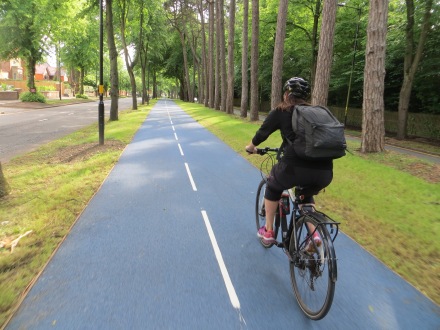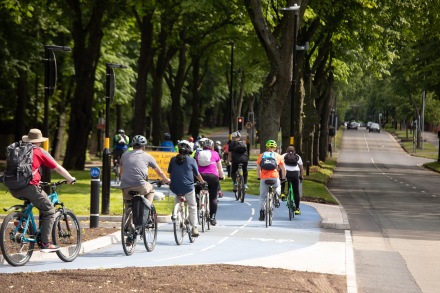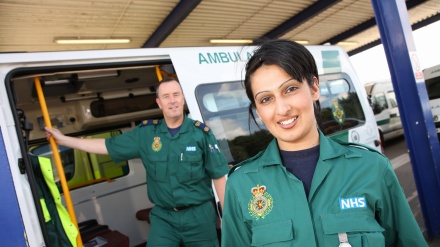In signing up to climate change pledges politicians are also signing up to a seismic public policy shift – especially for the way we travel

Climate change is the challenge of the century, both in terms of reducing greenhouse gas emissions and mitigating the worst effects of the continuum we are already on. We all kind of knew that. But the implications were just too hard to face. However, now that Greta Thunberg emerged to embody our unappeasable guilty conscience – city after city is declaring a climate emergency or a net zero target, or both. Nationally MPs have approved a motion to declare an environment and climate emergency and the UK Government became the first country to legally commit to become a net zero emitter of all greenhouse gas emissions by 2050.
In signing up to these pledges politicians of left and right are also implicitly signing up to the biggest public policy shift of the century. Because it implies government, nationally and locally, taking more control to remake the economy and society on sustainability principles and the rapid transformation of whole sectors of the economy, like transport and the built environment. All on a timescale so tight you wouldn’t want to start from where we were 10 years ago – never mind where we are now. And all at a time when our society feels horribly divided, paralysed by Brexit and with optimism a dwindling resource.
Some challenge. Especially if we intend to back up those big declarations with action and especially for transport (given the sector is now the largest greenhouse gas emitter in the UK). We will need a 21st century carbon reduction mania in transport to rival the railway mania that transformed the UK in the 19th century.
It will mean electrifying transport as rapidly as a greener grid can support it and as quickly as battery costs and availability come down. But this is going to take time, has its own significant challenges (including the embodied carbon in making these vehicles), so there is also a need to get people travelling in more efficient ways, such as 70 people sharing the same vehicle (a bus) or moving about without the need for any sort of engine (on a bike).
As our recent Number Crunch report shows, in the largest urban centres we are already seeing a shift to the more carbon and energy efficient transport modes. Cordon counts for the Birmingham am peak for example show a big increase in rail and a decrease in car commuting. Similar patterns can be seen in some of the other largest urban centres too – including in some areas a marked increase in cycling (though often from a low base) alongside strong growth in rail.
Largely missing from the modal shift party so far however is the bus. But the imperative provided by the need for rapid action on climate must surely be an opportunity for the bus to make a comeback. Especially because you can turn the funding up on bus services and see the benefits quickly. Handy too to have expanded bus services if you are planning to make it more difficult and expensive to drive, because some kind of alternative is there right away. It worked for Ken Livingstone when, as mayor of London, he flooded the streets with buses whilst simultaneously introducing congestion charging in 2003. He got re-elected too.
But this is not an opportunity that the bus industry currently looks in the state to capitalise on. Not structurally (Livingstone couldn’t have done what he did in a deregulated environment) nor when two of the ‘Big Five’ groups are up for sale and one of those is looking distinctly shop soiled. Indeed, with Greater Manchester now well down the franchising route and the end of Britain’s Big Five (and their unity in opposing franchising starting to crumble) there’s the feeling of an end of an era in the sector. A fresh start will be needed if the bus is to take the opportunity that net zero offers – including perhaps a major rethink of bus design (both exterior and interior) so that its face fits with both the look and feel that cities are aiming for and what might get travellers out of their cars.
However, much as the bus does have an opportunity from the climate crisis, the fact is that the car is still king outside the largest urban centres. More journeys are made by car than by any other means and much of the UK has also been made into a palace for King Car. For many people the places where they shop, work and spend their leisure time have been built on the rock solid assumption that there was no need to even consider that people might get there by any other means than the car. Even some of the places where we build buses and trains these days can be found in the middle of a car park in the middle of a nowhere that you can’t easily reach by bus or train. Of course these areas still need a public transport service, but given the overwhelming trip share of the car in vast tracts of the UK which have been built in the car’s image there must also be a role for increasing car occupancy rates through car sharing and through reducing the need for ownership through car clubs. But to make any of this happen we need some bold leadership. Cities and city regions that have signed up to net zero will also need to show leadership by looking at what they are spending their budgets on and to what extent these choices are making the biggest in-roads into reducing carbon fastest.
We also need national leadership on decarbonising transport – in particular on what the fiscal and taxation framework is going to be for vehicles which will in turn give consumers and manufacturers more confidence to embark on the ‘road to zero’ than they do now. The ‘road to zero’ needs to be short, straight, smooth and well lit, not the long, dark and unmade road it is now.
We also need a shift in spending priorities away from an inter-urban road building jamboree which is increasing carbon emissions whilst pointlessly redistributing traffic congestion and creating countless more high carbon, car dependent sprawl opportunities. This is money that could and should be spent on a rolling programme of rail electrification, taking measures to switch more short car journeys to active travel and increasing the journey share of low and ultra low emission buses on key corridors.
These are big vertiginous policy shifts – but far from unprecedented. The Netherlands was heading down our car dependent route until they made a big shift to the bike in the 1970s. Cities like Stockholm have a market share for public transport of 49%. London’s cycle superhighways, road pricing and taking out the gyratories would have been beyond the wildest aspirations of green transport campaigners 20 years ago. On power generation, carbon emissions halved in the UK in the eight years to 2016. Going further back we converted every gas appliance (20 million of them) across the country for natural gas in around a decade from 1967. Cities and city regions are also showing that they are increasingly prepared to take more direct control to make things happen for other goals too – from taking over tram systems and bus networks to providing utilities and building social housing.
On climate and carbon (as with much else besides) it feels these days that we are ‘poised between hope and despair’. And there is clearly the option of not looking Greta in the eye and sticking to the big statements without making the hard choices. Because the implications of the climate challenge is all too difficult, because other nations or sectors need to act first, and because, who knows, something may turn up. At the same time, taken together, the transport policy shifts may seem daunting, but broken down they are far from impossible – and all beneficial. The big pledges have been made on climate and now we can expect a new phase of much more intense scrutiny of the choices that are made on transport policy as a result.
Jonathan Bray is Director at Urban Transport Group
The blog first appeared in Passenger Transport Magazine.




